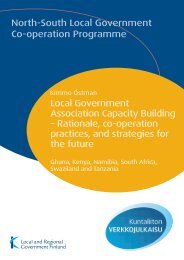E-READINESS QUESTIONNAIRE FOR NORTH ... - Kunnat.net
E-READINESS QUESTIONNAIRE FOR NORTH ... - Kunnat.net
E-READINESS QUESTIONNAIRE FOR NORTH ... - Kunnat.net
Create successful ePaper yourself
Turn your PDF publications into a flip-book with our unique Google optimized e-Paper software.
54<br />
�<br />
�<br />
�<br />
6.3 Economy<br />
0-14 years: 28.9% (male 7,093,328/female 7,061,579)<br />
15-64 years: 65,8% (male 16,275,424/female 15,984,181)<br />
65 years and over: 5.4% (male 1,075,117/female 1,562,860) (2009 est.)<br />
Other population indicators include:<br />
� Urban population: 61% of total population (2008)<br />
� Rate of urbanization: 1.4% annual rate of change (2005-10 est.)<br />
� Population: black African 79%, white 9.6%, colored 8.9%, Indian/Asian 2.5%<br />
(2001 census)<br />
� Religions: Zion Christian 11.1%, Pentecostal/Charismatic 8.2%, Catholic 7.1%,<br />
Methodist 6.8%, Dutch Reformed 6.7%, Anglican 3.8%, Muslim 1.5%, other<br />
Christian 36%, other 2.3%, unspecifi ed 1.4%, none 15.1% (2001 census)<br />
� Languages: IsiZulu 23.8%, IsiXhosa 17.6%, Afrikaans 13.3%, Sepedi 9.4%, English<br />
8.2%, Setswana 8.2%, Sesotho 7.9%, Xitsonga 4.4%, other 7.2% (2001 census)<br />
� Literacy: defi nition: age 15 and over can read and write<br />
total population: 86.4%<br />
male: 87%<br />
female: 85.7% (2003 est.)<br />
South Africa is a middle-income, emerging market with an abundant supply of natural<br />
resources; well-developed fi nancial, legal, communications, energy, and transport<br />
sectors; a stock exchange that is 18th largest in the world; and modern infrastructure<br />
supporting an effi cient distribution of goods to major urban centers throughout the<br />
region. Very much Africa’s superpower, South Africa has the continent’s biggest economy,<br />
though this went into recession in May 2009 following a sharp slowdown in the<br />
mining and manufacturing sectors. Growth was robust from 2004 to 2008 as South<br />
Africa reaped the benefi ts of macroeconomic stability and a global commodities boom,<br />
but began to slow in the second half of 2008 due to the global fi nancial crisis’ impact<br />
on commodity prices and demand. GDP fell by nearly 2% in 2009. The construction<br />
industry, on the other hand, has benefi ted from a huge programme of government investment<br />
ahead of the 2010 World Cup.<br />
Many South Africans remain poor and unemployment is high - a factor blamed for<br />
a wave of violent attacks against migrant workers from other African countries in 2008<br />
and protests by township residents over poor living conditions during the summer of<br />
2009.<br />
Land redistribution is an ongoing issue. Most farmland is still white-owned. Having<br />
so far acquired land on a “willing buyer, willing seller” basis, offi cials have signalled<br />
that large-scale expropriations are on the cards. The government aims to transfer 30%<br />
of farmland to black South Africans by 2014.<br />
South Africa has the second-highest number of HIV/Aids patients in the world.<br />
Around one in seven of its citizens is infected with HIV. Free anti-retroviral drugs are<br />
available under a state-funded scheme 70 .<br />
Unemployment remains high and outdated infrastructure has constrained growth.<br />
Daunting economic problems remain from the apartheid era - especially poverty, lack<br />
of economic empowerment among the disadvantaged groups, and a shortage of public<br />
transportation. More than one-quarter of South Africa’s population currently receives<br />
social grants.<br />
70 http://news.bbc.co.uk/2/hi/africa/country_profi les/1071886.stm




